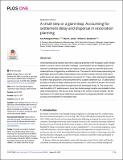Files in this item
A small step or a giant leap : accounting for settlement delay and dispersal in restoration planning
Item metadata
| dc.contributor.author | Rodriguez-Perez, Ana | |
| dc.contributor.author | James, Mark A | |
| dc.contributor.author | Sanderson, William G | |
| dc.date.accessioned | 2021-08-31T09:30:17Z | |
| dc.date.available | 2021-08-31T09:30:17Z | |
| dc.date.issued | 2021-08-18 | |
| dc.identifier | 275670247 | |
| dc.identifier | ab684a33-c121-48e7-a156-f4021399d20f | |
| dc.identifier | 34407139 | |
| dc.identifier | 85113330394 | |
| dc.identifier | 000686033500052 | |
| dc.identifier.citation | Rodriguez-Perez , A , James , M A & Sanderson , W G 2021 , ' A small step or a giant leap : accounting for settlement delay and dispersal in restoration planning ' , PLoS ONE , vol. 16 , no. 8 , e0256369 . https://doi.org/10.1371/journal.pone.0256369 | en |
| dc.identifier.issn | 1932-6203 | |
| dc.identifier.other | PubMedCentral: PMC8372959 | |
| dc.identifier.other | ORCID: /0000-0002-7182-1725/work/99466100 | |
| dc.identifier.uri | https://hdl.handle.net/10023/23874 | |
| dc.description | Funding: The project was funded by the Nesbit Cleland Trust (St Abbs Marine Station), Royal Haskoning DHV, Nature Scotland and the MASTS pooling initiative (the Marine Alliance for Science and Technology for Scotland). MASTS is funded by the Scottish Funding Council (grant reference HR09011). | en |
| dc.description.abstract | Understanding larval duration and hence dispersal potential of the European oyster Ostrea edulis is crucial to inform restoration strategies. Laval duration has an obligatory period of maturity to pediveliger (when larvae are ready to settle), but also an unknown period until metamorphosis is triggered by a settlement cue. The extent to which larvae can prolong the pediveliger period and delay metamorphosis has not been studied. Here we show that O. edulis larvae can delay metamorphosis for a period of 11 days, while retaining the capability to settle in high proportions when presented with a suitable settlement cue. O. edulis larvae are likely to be able to delay metamorphosis even further, since 80% of larvae in the control treatment were still alive when the experiment was terminated at day 14. The results indicate the ability of O. edulis larvae to more than double pelagic duration and probably further delay metamorphosis. We discuss these findings in the context of larval mortality, and the importance of O. edulis' larval settlement requirements for dispersal potential, recruitment success and connectivity of restoration sites. | |
| dc.format.extent | 14 | |
| dc.format.extent | 1402537 | |
| dc.language.iso | eng | |
| dc.relation.ispartof | PLoS ONE | en |
| dc.subject | GC Oceanography | en |
| dc.subject | QH301 Biology | en |
| dc.subject | NDAS | en |
| dc.subject.lcc | GC | en |
| dc.subject.lcc | QH301 | en |
| dc.title | A small step or a giant leap : accounting for settlement delay and dispersal in restoration planning | en |
| dc.type | Journal article | en |
| dc.contributor.institution | University of St Andrews. School of Biology | en |
| dc.contributor.institution | University of St Andrews. Scottish Oceans Institute | en |
| dc.contributor.institution | University of St Andrews. St Andrews Isotope Geochemistry | en |
| dc.contributor.institution | University of St Andrews. Coastal Resources Management Group | en |
| dc.contributor.institution | University of St Andrews. Marine Alliance for Science & Technology Scotland | en |
| dc.identifier.doi | https://doi.org/10.1371/journal.pone.0256369 | |
| dc.description.status | Peer reviewed | en |
This item appears in the following Collection(s)
Items in the St Andrews Research Repository are protected by copyright, with all rights reserved, unless otherwise indicated.

